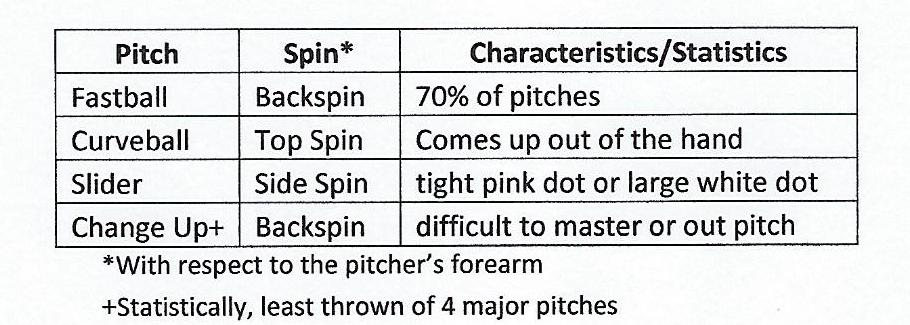In the previous videos, we’ve discussed where vision plays in the ability to be a successful hitter and the importance of visual acuity for hitters. In this video, we are going to discuss what the physical characteristics and statistics of the most common pitches as it doesn’t make much sense if a hitter has great visual acuity but has no idea what they need to look for.
My goal here is to explain the details of the 4 most common pitches (fastball, curveball, slider and changeup) in easy and simple terms. But first, I want to stress two major things: First, the details of each pitch are based on the Law of Physics. These laws were discovered way before baseball was even invented and they DO NOT CHANGE! Basically, the Law of Physics states that if you want a baseball to move in a certain direction (i.e. curve, slide, etc.) it has to spin in the direction you want it to move. That’s it, there is no magic pixie dust a pitcher can sprinkle on the ball to make it defy the laws of physics. Yes, some pitchers are blessed to have exploding fastballs or knee buckling curves or a devastating changeup. But the only difference between their pitches and an average little leaguer is 1) pitch velocity and 2) spin velocity. The main point is that the spin is the spin is the spin. It can’t change and that is the most obvious characteristic that determines what the pitch is. So if the hitter can recognize the spin, they know the pitch. I do believe it is that simple.
The second thing I want to put out there is that, biomechanically, if a pitcher wants to make a ball move a certain direction, there is only one way they can release it out of their hand (as we show in the video). Again, there can be no deviation.
There is one last thing, when I talk about spin direction in the following paragraphs; I’m strictly talking about direction in reference to the pitcher’s forearm and not their arm slot or release point.
So now let’s discuss the four major pitches and their characteristics and spins:
Changeup
I want to start with the changeup first. Statistically, the changeup is the least thrown of the 4 major pitches. However, a good changeup, well executed, is a devastating pitch because it mimics the fastball rotation (backspin – I’ll go over that later) with the only differences being a little “whiter” due to decreased spin rotation. But the silver lining is that it is a very difficult pitch to master. Typically, a pitcher that hasn’t developed a good changeup will give it away in other ways. They may slow down their body or their arm. Or they may drop their elbow to try and “push” it. Or they may completely change their arm slot. So there are some fairly obvious signs to predict a “bad” changeup is coming.
But if a pitcher has one of those devastating changeups, although a lot more difficult, there are still some ways to make an educated guess its coming. A baseball is a statistics driven sport, let’s use statistics to our advantage. A pitcher with a developed changeup is statistically not going to throw it every pitch, so when are the most advantageous situations for them to throw it? In my opinion, there are 2 predominate situations they, statistically, would use their change up: 1) to get ahead in the count and 2) as the out pitch. This, of course, is not a certainty and sometimes you just have to tip your hat to the pitcher.
Fastball
The fastball is the most common pitch any hitter will see. Statistically speaking, it’s thrown around 70% of the time. Whether it’s a 2-seam or a 4-seam fastball, it’s characterized by its backspin due to the ball coming off the pitcher’s fingertips with the pitcher’s palm facing the hitter (again, due to biomechanics). There is not really more I can add regarding the characteristics of the fastball.
However, I would like to add one last food for thought on the fastball. The fastball gives the hitter the least amount of reaction time to swing and is the most common pitch a hitter will see. So with those two facts in mind, if a hitter can be prepared to hit the fastball, with a little swing discipline, they will be prepared to hit any of the other pitches. This is because it easier to delay the start of the swing on an off-speed pitch than to try to catch up to a misread fastball.
Curveball
The curveball’s main characteristic is the top spin due to the ball coming off the side of the fingers with the pinky finger side of the pitcher’s hand facing the hitter. Additionally, the ball may seem like it comes up out of the pitcher’s hand rather than on a straight plane like the fastball. However, as an individual pitcher becomes more advanced and stronger, this “up and out” characteristics will become less noticeable.
Slider
The slider’s main characteristic is that it looks just like a fastball coming out of the pitcher’s hand (palm facing hitter) but it will have side spin AND either an off-center tight pink dot or large white dot (depending on how the pitcher grips the ball).
In summary, I want to stress the following points of this video and I’ve added a quick reference table below:
- The Law of Physics dictates pitch rotation and cannot change
- The biomechanics of the release point of each pitch is unique and cannot change
- As stated above, a good changeup is a rarity
- Therefore, there are 3 major pitches with 3 distinct and different rotations


